June 27 Lava Flow Update – 2/28/15
Saturday morning’s Hawai’i County Civil Defense overflight showed no change in any of the downslope flow areas of the June 27 lava flow.
Civil Defense reported that breakouts continue along the north and south margin of the flow, as well as on the pad itself, providing indication that lava is still traveling through the tube.
Hawaiian Volcano Observatory conduced an overflight assessment of the flow on Friday afternoon and mapped its perimeter.
According to HVO, scattered breakouts were observed upslope from the stalled flow tip along the north margin that stop advancing last Monday. The breakouts began about 1.7 miles above the inactive tip.
Additional breakouts were observed west of the Kaohe Homesteads subdivision.
Further upslope on the flank of Puʻu ʻŌʻō, HVO observed a breakout that had advanced about 90-110 yards since Monday, Feb. 23.
Following its overflight HVO, also noted two active breakouts in the Kahauale’a area. The breakout located in a more northerly direction was no longer spreading into the forest. HVO also reported that surface flows were scattered within the flow. The north breakout reportedly advanced about 550 yards since Monday, Feb. 23 but the leading edge was not active during the overflight.
None of the lava activity posing a threat to communities in the area at the current time. Civil Defense, along with Hawaiian Volcano Observatory, will continue to monitor conditions and informed the public of any changes.
Light to moderate smoke conditions were reported Saturday morning as a light northwest wind was blowing smoke in a southeast direction. As usual, these conditions have the possibility of changing. Individuals who are sensitive should take necessary precautions.

The leading tip of the June 27 flow remained stalled about 500 meters (550 yards) from Highway 130, as of Friday, Feb. 27, but scattered breakouts remain active upslope of the stalled tip. USGS HVO photo.
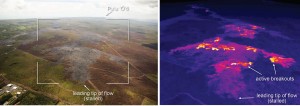
This comparison of a normal photograph and a thermal image shows the leading portion of the June 27 flow. The white box shows the rough extent of the thermal image. In the thermal image, the active breakouts are visible as yellow and white pixels, and these areas are scattered upslope of the stalled tip of the flow. USGS HVO photo.
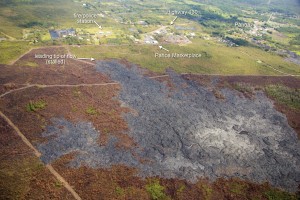
Another view of the leading tip of the June 27th flow, looking downslope towards Highway 130. USGS HVO photo.

This photograph looks southeast at the fork in the June 27 flow that is just west of Kaohe Homesteads. The east branch (top portion of photo) crossed Apaʻa St. and entered Pāhoa in late October, and this branch is now inactive. The west branch (lower portion of photo) has headed towards areas at the north end of Pāhoa, and remains active. USGS HVO photo.
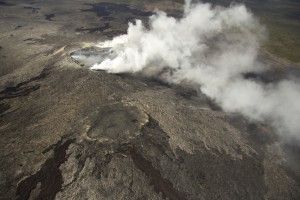
The breakout on the north flank of Puʻu ʻŌʻō that began last weekend remains active, but has advanced only a minor distance over the past four days. The new breakout is visible as the light-colored area just to the right of the center of the photograph. Puʻu ʻŌʻō Crater is in the upper left portion of the photograph. USGS HVO photo.

This view looks west and shows the depression within Puʻu ʻŌʻō Crater. This depression formed following the start of the June 27 lava flow. USGS HVO photo.

A closer look at a glowing hole in the northeast pit in Puʻu ʻŌʻō Crater. Recent overflows from the opening created the dark flows filling the bottom of the pit. USGS HVO photo.
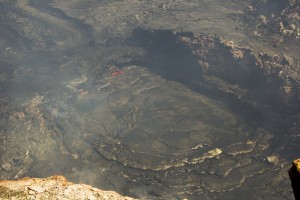
This lava pond was active in the southern pit in Puʻu ʻŌʻō crater. The diameter of the lava pond was roughly 18 m (60 ft). Weak spattering was active on the pond margin. USGS HVO photo.
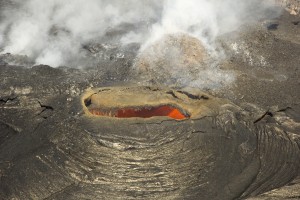
A closer look at the hole in the northeast pit. An active, bubbling lava surface could be seen a couple meters (yards) below the rim. USGS HVO photo.

Photo taken on Feb. 26 during a June 27 lava flow overflight. Photo credit: Extreme Exposure Media/Paradise Helicopters.
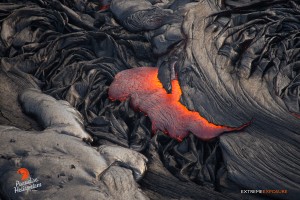
Photo taken on Feb. 26 during a June 27 lava flow overflight. Photo credit: Extreme Exposure Media/Paradise Helicopters.

Photo taken on Feb. 26 during a June 27 lava flow overflight. Photo credit: Extreme Exposure Media/Paradise Helicopters.

Photo taken on Feb. 26 during a June 27 lava flow overflight. Photo credit: Extreme Exposure Media/Paradise Helicopters.
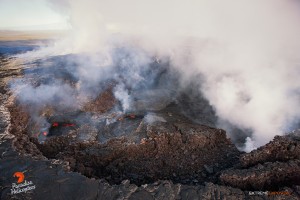
This photo, taken Feb. 26, shows a couple of collapsed pits that had been sloshing lava within Pu‘u ‘O‘o crater. Photo credit: Extreme Exposure Media/Paradise Helicopters.
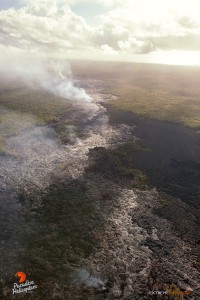
This photo, taken Feb. 26, shows an expansive view of the flow field with gases escaping the main tube that supplies the leading edge. Photo credit: Extreme Exposure Media/Paradise Helicopters.
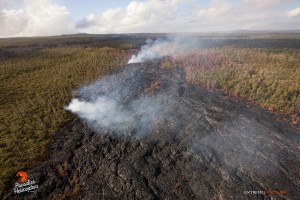
This photo, taken Feb. 26, shows a couple of hot spots just downslope of the old geothermal pad. Photo credit: Extreme Exposure Media/Paradise Helicopters.
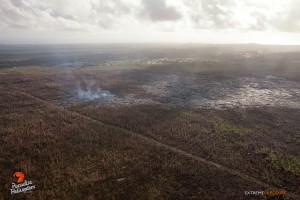
In this photo, taken Feb. 26, minimal activity was occurring in the vicinity of the leading edge. Photo credit: Extreme Exposure Media/Paradise Helicopters.

This large-scale map uses a satellite image acquired in March 2014 (provided by Digital Globe) as a base to show the area around the front of Kīlauea’s active East Rift Zone lava flow. The area of the flow on February 23 is shown in pink, while widening and advancement of the flow as of February 27 is shown in red. The blue lines show steepest-descent paths calculated from a 1983 digital elevation model. USGS HVO map.

This map overlays a georegistered mosaic of thermal images collected during a helicopter overflight of the distal part of Kīlauea’s active East Rift Zone lava flow on February 27 at about 11:40 AM. The base image is a satellite image acquired in March 2014 (provided by Digital Globe). The perimeter of the flow at that time is outlined in yellow. Temperature in the thermal image is displayed as gray-scale values, with the brightest pixels indicating the hottest areas (white areas are active breakouts). The blue lines show steepest-descent paths calculated from a 1983 digital elevation model. USGS HVO map.

This map overlays a georegistered mosaic of thermal images collected during a helicopter overflight of Kīlauea’s active East Rift Zone lava flow west of Kaohe Homesteads on February 27 at about 11:35 AM. The perimeter of the flow at that time is outlined in yellow. Temperature in the thermal image is displayed as gray-scale values, with the brightest pixels indicating the hottest areas (white areas are active breakouts). USGS HVO map.
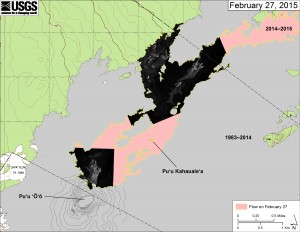
This map overlays georegistered mosaics of thermal images collected during a helicopter overflight of Kīlauea’s active East Rift Zone lava flow near Puʻu ʻŌʻō on February 27 at about 11:50 AM. The perimeter of the flow at that time is outlined in yellow. Temperature in the thermal image is displayed as gray-scale values, with the brightest pixels indicating the hottest areas (white areas are active breakouts). USGS HVO map.

















